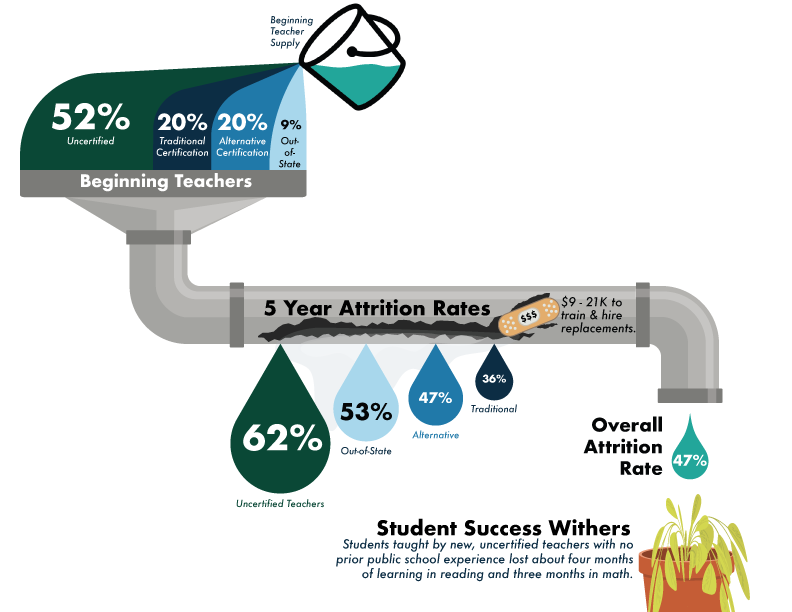2025 POLICY PRIORITY
STRENGTHEN THE TEACHER WORKFORCE.
THE PROBLEM: A LEAKY PIPELINE

of New, First-Time Teacher Hires in the 22-23 School Year Were Uncertified
Texas is struggling to recruit and retain highly-qualified teachers. Turnover is at an all-time high, primarily among under-prepared beginning teachers.1 To quickly meet this demand, districts are increasingly relying on an astonishing number of uncertified teachers – of all newly-hired, beginning teachers employed in 2022-2023, an alarming 45% were uncertified, and 20% did not even have a Bachelor’s degree, especially in rural areas.2 Inaccess to high-quality and affordable preparation pathways, uncompetitive compensation, and a lack of transparency, accountability, and technical assistance are some of the most pressing challenges contributing to this leaky pipeline.
WHY IT MATTERS
Inexperienced, underprepared teachers have a negative effect on student learning and leave the profession at higher rates.
According to a study conducted by researchers at Texas Tech University, students taught by uncertified, inexperienced teachers lose about four months of learning in reading and three months in math, are significantly underdiagnosed for dyslexia, and are more chronically absent.3 Uncertified teachers also leave the profession at three times the rate of other teachers,4 costing districts up to $20,000 per vacancy.5
Teachers who exit the profession cite low compensation, poor working conditions, and low-quality training as main drivers.
Unfortunately, teachers are subjected to a high “pay penalty” – the negative gap between wages earned by teachers compared to college graduates in other professions – and this is especially worse between urban and rural teachers.6 Additionally, teachers who are highly-effective, yet uncertified, might not have a clear pathway to higher compensation and certification.
GOOD NEWS: high-quality preparation models SHOW BRIGHT SPOTS
Momentum is particularly strong for teacher residencies, apprenticeships, and “grow-your-own” programs.
Teacher residency and apprenticeship programs are highly effective in retaining teachers – studies show that Texas teachers who complete a year-long residency program are 92% more likely to stay in the profession after three years.7 However, residencies are expensive. Because it is a year-long clinical teaching experience, teachers-in-training are either foregoing the pathway altogether to take a more immediate paycheck, or they are taking out additional loans to cover their tuition and salary. Some preparation providers and districts are covering the tuition and salary costs for their students, but they are struggling to sustain these benefits without additional state funding. Improving and incentivizing access to affordable, high-quality preparation programs ensures the teacher pipeline remains intact.
The Teacher Incentive Allotment (TIA) is a proven, successful compensation system.
Created by the Legislature in 2019, the TIA awards districts an additional $3,000 – $32,0008 for each designated teacher based on teacher performance, campus location, and student need. In 2024, 597 school districts are participating in the TIA, with over 26,000 teachers generating $290 million in additional compensation,9 and these numbers are rapidly growing. TIA districts are more likely to be rural and/or serve high-need populations and have higher levels of teacher retention, employee satisfaction, and student achievement.10 Rewarding effective teachers through increased compensation and opportunities for growth will likely keep more teachers in the profession.
WHAT TO DO IN 2025
- Create and fund multiple pathways to teacher certification, including an allotment to support teacher residencies and apprenticeships for beginning teachers
- Expand the Teacher Incentive Allotment to let more teachers access the potential to earn a six-figure salary, and support strategic staffing initiatives
- Waive certification fees for high-need certification areas
- Increase the Mentor Program Allotment
FOOTNOTES
1. Employed Teacher Attrition and New Hires 2014-15 through 2023-24. Texas Education Agency, March 2024.
2. Kirksey, J. Amid Rising Number of Uncertified Teachers, Previous Classroom Experience Proves Vital in Texas. Texas Tech University, 2024
3. Kirksey, J., 2024.
4. Teacher Employment, Attrition, and Hiring. Texas Education Agency, March 2024.
5. What’s the Cost of Teacher Turnover? Learning Policy Institute, September 2017.
6. Allegretto, Sylvia. Teacher Pay Penalty Still Looms Large: Trends in Teacher Wages and Compensation through 2022. Economic Policy Institute, September 2023.
7. Why Teacher Residencies Need to be the Standard. US Prep National Center, 2023.
8. CREATING A MORE SUSTAINABLE TEACHING JOB IN TEXAS: An In-Depth Look at the Teacher Incentive Allotment. Education Resource Strategies, May 2024.
9. 2023-2024 Teacher Incentive Allotment Annual Report. Texas Education Agency, September 2024
10. Education Resource Strategies, May 2024.